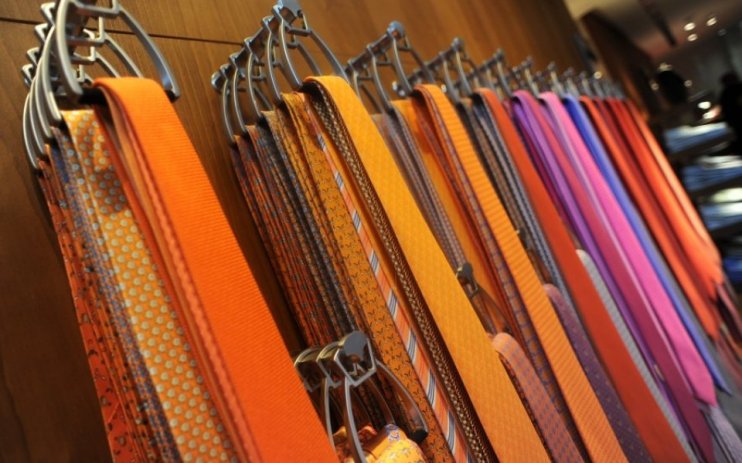Why we must resurrect the tie from this boorish open-collar culture

Since the general demise of hats, the most vulnerable, because the most superficially dispensable, piece of a gentleman’s wardrobe is the tie. In politics, we have perhaps David Cameron to blame for pioneering the look of dark suit and open-necked white shirt which may have been a carry-over from his days in public relations.
For many people, of course, a shirt and jacket, even without a tie, represents the apex of formality in their professional lives. I’m looking at you here, tech bros and start-ups and venture capitalists. Dispensing with the tie, which was still holding firm sway in the last millennium, was a simple and easy way of indicating one’s informality and dangerous iconoclasm. Take off your tie and jump out of the box.
I don’t like it, let me be honest at the outset. For one thing, the Cameron look is actually quite difficult to pull off—unless the shirt and suit are both well-cut and made of expensive material, it simply looks odd, incomplete, hastily assembled. DC, of course, despite his professed lack of interest in clothes, was dressed by Richard James and G.D. Golding, and therefore was comfortable seeing four figures on the horizon when the bill was presented. It is also, now more than ever, a lazy cliché, shorthand for “I defy convention” and “I’m not vain”. Neither is true.
For me, ties are the completion of formal professional dress, the balancing of the gentleman’s appearance, and, importantly, an opportunity for a degree of personal taste and display when the other elements are circumscribed. Ties seem simple, but patterns and textures can run riot and communicate a huge amount in a very concise and eloquent way.
Plain ties are very de rigeur. We’ve all seen them as part of the armoury of those who don’t want any hostages to fortune: navy suit, white shirt, slightly shiny tie from a safe palette like reds or blues. It’s all too distressing and dull. If you really want to wear a plain-coloured tie, choose something in a knitted silk: navy, burgundy, bottle green, gold and pink are all fetching (I can attest from experience), and the heavy waffle of the material gives texture and depth. It’s also what James Bond wore, if that excites you: a black knitted silk tie from Jermyn Street legends Turnbull and Asser. I find black a bit stark and funereal, but navy works very well.
So we turn to patterned ties. One section which seems less favoured now is the school/regimental/club tie. They are thought to be very old-fashioned, but I have a substantial collection: one school, four university variants, one club and a few other institutions. I like the regularity of stripes or repeated motifs, and I have a dread of false advertising by wearing through inadvertence a tie to which I’m not entitled (I had a striped tie at school that was very similar to the Brigade of Guards, and it was a Very Bad Matter).
The big boys in neckwear are brands like Hermès, Charvet (worn by Sebastian Flyte) and Marinella. You can always go to the traditional English tailors, or the major fashion labels like Tom Ford and Ralph Lauren. What is important is to find something in a reasonably heavy fabric so that it ties a solid and durable knot. Too shiny and the knot may begin to slip; too thin and it will end up like a disastrous attempt at a bolo tie.
A word here on tie knots. You can find endless variations but really only three are necessary: the four-in-hand, the Windsor and the half-Windsor. I use a four-in-hand, because it is versatile and my muscle memory works in that direction (I suppose I learned to tie one 40 years ago). If your shirts have wider collars, you may wish for a chunkier knot to fill the gap, which leads towards the Windsor. Do not, however, end up looking like a would-be footballer with a tie knot the size of a carbuncle at your throat.
Colour and patterns allow you a flourish of individuality. You must take account of the colour of your shirt, of course, but purple works well, as does a rich dark green, or a luscious gold. You may like a small, repeated motif—Roderick Charles offers some quirky little devices like lobsters and elephants—or something more abstract. Hermès are kings of the discreet detail, especially interlocking or abutting Hs, and famously their label in on the outside of the thin blade of the tie, allowing it ‘accidentally’ to pop into view and hint at its wearer’s wealth and status.
Your tie should be the exquisite culmination of your dressing. Suit and shirt are fine, and the choices are considerable, but they will tend to fade into the background when a well-chosen tie is front and centre. Get the knot and the length right—the large blade should have its tip a little below your waist—and deploy your palette properly, and you have not only completed but sharpened and enlivened your overall composition.
It may not be edgy or casual, but a good tie shows you like quality products and mean business. I’m working my way through my collection, so if you’ve fallen out of the habit, button your collar, sling the corporate noose round your neck and announce that you’ll be tied up all week.